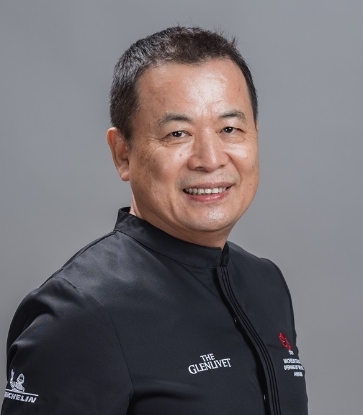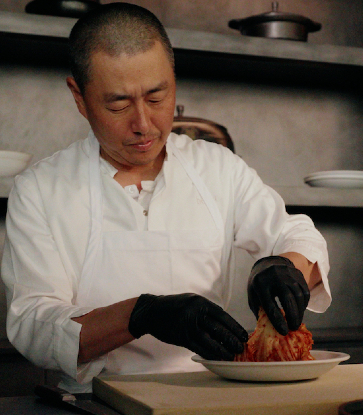In Hong Kong and Macau, auspicious dishes are often enjoyed during reunion dinners on Lunar New Year’s Eve. Two of the classics are Braised Pork Knuckles with Fermented Red Beancurd, which symbolises luck and fortune; as well as the Braised Shiitake Mushrooms with Dried Oysters and Black Moss — a dish that signifies prosperity and well wishes. We speak to executive chef Chan Tak-kwong of two-MICHELIN-Starred Wing Lei in Macau and chef Cheung Kin-ming of two-MICHELIN-Starred Ying Jee Club in Hong Kong for their secrets of how to perfect these two lucky dishes.

“There are two key points to making Braised Pork Knuckles with Fermented Red Beancurd,” says Cheung (pictured on the right). “The first one is to ask the butcher to burn off all the pig’s hair with high heat, as this is very difficult to handle at home. Then, you can ask them to cut up the pork knuckle into pieces of around 4 tael (approx. 150g) each. When cooking, be sure to simmer and cook the pork knuckle over medium heat, then turn off the heat and let it rest in the residual heat. This will give the pork knuckle a tender and springy texture.”
Chan also agrees with prioritising the quality of ingredients. He suggests getting good-quality pork knuckles from the wet market to ensure a tender texture, and asking for the butcher’s help to cut up the pork knuckle. Once you’re home, if you notice that there are still hairs on the pork knuckle, you can hold onto the hairs with a pair of tweezers and carefully burn them off.
Then, in a pot of boiling water, blanch the pork knuckle with ginger, spring onions, and star anise before giving it a thorough wash. It’s important to ensure that the pig’s odour is gone. Some people choose to fry the pork knuckle before cooking. This process makes it easier for the skin to gain colour and less likely to disintegrate during braising. However, both chefs believe that deep-frying at home is too troublesome and unhealthy due to excessive oily residue and smoke.

Next, you can proceed with cooking the pork knuckle. Chan explains, “In a wok, add seasoning ingredients such as ginger, spring onions, garlic, star anise, and cinnamon. Adding red chilli peppers can help lift the flavours, but be careful not to add garlic too early, as it can easily burn and become bitter. Once the wok gets hot, sauté these ingredients until they become fragrant, then add fermented beancurd and chu hou sauce until they start releasing their aromas. This would be the time to add pork knuckle and stir-fry it. Add rice wine and water, and start simmering the pork knuckle over low heat.” The size of the pork knuckle determines how long you need to braise it for. The cooking time can also be adjusted based on personal preference: cook it for longer if you prefer a softer, tender texture, and remove the pork knuckle at the appropriate time if you want it to be chewier.
When the pork knuckle reaches the desired texture, you can then season it by adding dark soy sauce, oyster sauce, and rock sugar. “At Wing Lei, we also add red dates to give the dish a pleasant sweetness and Jinhua ham for a touch of umami. These ingredients are better than sugar and can help elevate the whole dish,” Chan remarks. Cheung also seasons the dish in a similar way, and suggests buying bottled fermented beancurd for a better taste.
As for whether or not to add other ingredients, it is entirely up to you. During Lunar New Year, you can add ingredients that symbolise abundance and auspiciousness, such as black moss, dried mushrooms, and beancurd sticks. Vegetables like lettuce and bok choy are both excellent choices as well. Both chefs agree that lotus root, kudzu, and radish are the best accompaniments for braised pork knuckle as they complement each other exceptionally well.
Bearing home cooks in mind, both chefs suggest to cook pork knuckle and lotus root in the kudzu and lotus root soup before removing the pork knuckle for braising. This method not only reduces the pork knuckle’s cooking time, but also give the soup a richer flavour. “Take out the lotus roots and add them to the braised pork knuckle dish. It’s quick and convenient, and you’re getting two dishes out of one ingredient. This is the wisdom of a home cook,” explains Cheung, who also suggests that the braised pork knuckle dish can be prepared a day in advance since it tastes even better the next day.
Another must-have Chinese New Year dish is Braised Shiitake Mushrooms with Dried Oysters and Black Moss. It may look like a complicated dish, but in fact, the dish is not difficult to make as long as you choose good ingredients.

Let’s start with black moss. There are many low-quality black moss products in the market that tend to dissolve when cooked. High-quality black moss will retain structural integrity in each strand even after cooking. To choose good-quality black moss, it’s necessary to inspect and feel the texture to ensure it is clean and without any impurities. If you’re unsure, it’s best to buy black moss from a reputable store. Black moss must be soaked before use. Both chefs recommend adding a bit more oil during cooking to lend a smoother texture.
Next is dried oysters. Chan says, “choose dried oysters that have a distinct oyster flavour and a nice sheen.” Once purchased, the dried oysters need to be stored properly. Chan suggests sun-drying then storing them in the freezer. If you don’t have a freezer, they can be stored in the fridge at below 8°C. However, dried oysters should not be stored for too long as they spoil rather easily. Chan prefers using semi-dried oysters, which are ready for cooking after soaking in water for one to two hours. They are more convenient than dried oysters, and have a more fragrant flavour and a smoother, softer texture. The water used to soak dried oysters can be kept and used in the braising process.
For the dried mushrooms, it’s recommended to braise them in advance. Both chefs recommend simmering them in soup so they can become more tender, which saves time and effort in the later cooking process. Taking the kudzu and lotus root soup, for example. The shiitake mushrooms can be added into the soup, and only seasoned once they have softened.
Chan offers an even more detailed cooking method: in a pot, add ginger, spring onions, garlic and lard for aroma, then add in the mushrooms and mushroom water. Cover with lid and let the ingredients simmer for around 10 minutes. Oyster sauce, sugar, and chicken powder can then be added according to personal preference, and be sure to observe the consistency of the sauce when reducing it. In summary, the key to cooking dried mushrooms lies in controlling the cooking temperature and seasoning the ingredients at the right time to ensure a tender texture and balanced flavour.
Although neither restaurants are serving Braised Pork Knuckles with Fermented Red Beancurd, nor the Braised Shiitake Mushrooms with Dried Oysters and Black Moss, the two chefs have generously shared their personal home recipes with us:
Braised Pork Knuckles with Fermented Red Beancurd
By Chef Cheung Kin-ming of Ying Jee Club
Ingredients
1 pork knuckle6 ginger slices
20g spring onion strips
A dash of cooking wine
1,000ml chicken broth
Seasoning
2 large blocks of fermented red beancurd 5g chu hou sauce
40g oyster sauce
40g rock sugar
25g light soy sauce
A dash of dark soy sauce
Steps
1. Ask the butcher to help burn off and remove the pig’s hairs, then chop the pork knuckle into pieces of around 4 tael (approx. 150g) each. 2. Soak the pork knuckle in salt water to remove any blood. Bring a pot of water to the boil, then add half the ginger slices and cooking wine. Blanch the pork knuckle for around 10 minutes.
3. Heat up a wok and stir-fry the remaining ginger and spring onions until fragrant. Add the pork knuckle and seasonings, stirring until well coated before adding chicken broth. Cook for 15 minutes over high heat, then switch to the lowest heat setting and simmer for 45 minutes. Turn off the heat and let it rest until reaching room temperature.
4. Before serving, reheat the dish, adding a touch of cornstarch mixed with water to thicken the sauce. Enjoy!

Braised Shiitake Mushrooms with Dried Oysters and Black Moss
Photo on the left is provided by Chef Cheung Kin-ming of Ying Jee Club
Recipe is by Chef Chan Tak-kwong of Wing Lei
Ingredients
10 pieces of dried shiitake mushrooms40g black moss
400g dried oysters
200g roast pork, chopped
5g ginger slices
5g spring onion strips
2 cloves of garlic
1 tbsp of wine
1 cup of water
Pepper powder, to taste
2 tbsp of oyster sauce
1 tbsp of sugar
1 tsp of chicken powder
Ingredients (for stewing the shiitake mushrooms)
5g ginger slices5g spring onion strips
2 cloves of garlic
Approx. 2 cups of water (from soaking the mushrooms)
2 tbsp of oyster sauce
1 tbsp of sugar
1 tsp of chicken powder
Steps
1. Place the dried mushrooms in water. Discard the water with impurities and further soak the mushrooms in clean water for two hours. Set aside the mushroom water for later. In a pot, add ginger, spring onions, garlic, and lard; and stir-dry until fragrant. Add the soaked mushrooms and mushroom water, and braise until softened. Add seasoning and simmer over low heat to reduce the sauce.2. Soak the dried oysters for 30 minutes, removing any sand or shell fragments. Soak black moss in water and check for sand or debris. Change water and soak for a further 20-30 minutes.
3. Stir-fry ginger, spring onions, and garlic until fragrant. Add the roast pork and stir-fry until it releases aroma. Add the soaked oysters and braised mushrooms, and gently stir-fry. Add cooking wine, then water and pepper powder. Cover with lid and let it simmer for 10 minutes. In the last two minutes of cooking, add black moss and bring to a boil. Then, season by adding oyster sauce, sugar, and chicken powder. If the sauce is too watery, thicken it with cornstarch water. Finish with a drizzle of peanut oil. Alternatively, this dish can be served over a bed of lettuce blanched with oil, salt, and water.


















